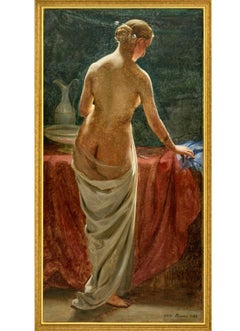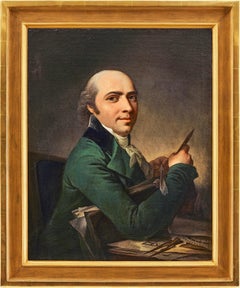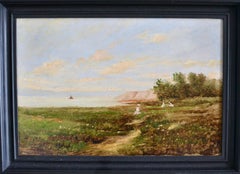Want more images or videos?
Request additional images or videos from the seller
1 of 20
UnknownLast Judgement, 17th or 18th Century Follower of Hieronymus Bosch17/18th century
17/18th century
$6,916.28List Price
About the Item
- Creation Year:17/18th century
- Dimensions:Height: 37.8 in (96 cm)Width: 44.49 in (113 cm)Depth: 1.58 in (4 cm)
- Medium:
- Movement & Style:
- Period:
- Condition:Fair condition with some paint losses on the outer parts of the painting. Varnish is dirty and yellow and the painting needs a restoration. The canvas has been relined. The top section (about 3cm) probably added later to fit the frame.
- Gallery Location:Stockholm, SE
- Reference Number:1stDibs: LU2608215570432
About the Seller
5.0
Gold Seller
Premium sellers maintaining a 4.3+ rating and 24-hour response times
1stDibs seller since 2023
33 sales on 1stDibs
Authenticity Guarantee
In the unlikely event there’s an issue with an item’s authenticity, contact us within 1 year for a full refund. DetailsMoney-Back Guarantee
If your item is not as described, is damaged in transit, or does not arrive, contact us within 7 days for a full refund. Details24-Hour Cancellation
You have a 24-hour grace period in which to reconsider your purchase, with no questions asked.Vetted Professional Sellers
Our world-class sellers must adhere to strict standards for service and quality, maintaining the integrity of our listings.Price-Match Guarantee
If you find that a seller listed the same item for a lower price elsewhere, we’ll match it.Trusted Global Delivery
Our best-in-class carrier network provides specialized shipping options worldwide, including custom delivery.You May Also Like
Óleo sobre tela - La virgen con el niño y san Juanito
Located in Sant Celoni, ES
Sin firmar, de autor anónimo
Se presenta enmarcada la obra con un marco posterior a la pintura
Comentar que la tela está reentelada
Medidas obra: 65 x 49 cm.
Medidas marco: 82 ...
Category
Mid-18th Century Old Masters Figurative Paintings
Materials
Oil
Turn of the 20th Century French tryptic depicting the Annunciation with 2 saints
Located in Petworth, West Sussex
A. Lion (French, c. 1900)
A tryptic depicting the Annunciation flanked by two Saints
Signed “A. LION” (to the left of Mary)
Oil on board
Framed dimensions 23. ½ x 37. ½ in. (60 x 95...
Category
19th Century Old Masters Figurative Paintings
Materials
Oil, Board
$3,000
H 23.5 in W 37.5 in D 2 in
Answer Within
Located in Ibadan, Oyo
Painting
Ships in a well-protected tube from Nigeria
This work is unique, this is not a print or other type of copy.
Accompanied by a Certificate of Authenticity (Issued by the Gallery)
Category
21st Century and Contemporary Old Masters Portrait Paintings
Materials
Canvas, Oil
Antique English 19th century marine scene
By William Anderson
Located in Woodbury, CT
Outstanding English late 18th / early 19th century marine scene by one of Britain's best known and sought after painters.
William (or Wiliam) Anderson (1757 – 27 May 1837) was a Scottish artist specializing in maritime and patriotic themes. He was well-regarded for his detailed and accurate portraits of ships under sail, exhibiting his works annually in London between 1787 and 1811 and then occasionally until 1834. Anderson influenced other artists, notably John Ward and others of the Hull school.
Anderson's early life is obscure, but he is known to have trained as a shipwright before moving to London to become a maritime painter when he was about 30. His training served him well as a painter, providing "a practical nautical knowledge" of his subjects. He earned a reputation for "accuracy and refinement of detail" and was admired for his bright, clear colours. He worked in both oils and watercolours.
He based his style on that of well-known Dutch maritime...
Category
1810s Old Masters Figurative Paintings
Materials
Oil, Wood Panel
$5,167 Sale Price
35% Off
Free Shipping
H 8 in W 10 in
19th Century English Antique, Two Country farmers drinking beer in a landscape
By George Morland
Located in Woodbury, CT
Attributed to George Morland.
19th Century English Antique, Two Country farmers drinking beer in a landscape.
Wonderful early 19th-century original oil on canvas.
A classic 'Morland' composition as the painter was a big fan of English Pub scenes...
Category
Early 1800s Old Masters Figurative Paintings
Materials
Canvas, Oil
$2,765 Sale Price
30% Off
Free Shipping
H 20 in W 16 in
Landscape With Pan and Syrinx, Flemish School From the 1600s, Oil on Copper
Located in Stockholm, SE
Flemish School, 1600s
Landscape With Pan and Syrinx
painted around the 1600s
oil on copper
19 x 23.5 cm
frame 29 x 34 cm
Hand-made oak frame by Swedish frame maker Christer Björkma...
Category
17th Century Old Masters Landscape Paintings
Materials
Copper
$5,366
H 11.42 in W 13.39 in
Still life
Located in Genève, GE
Work on canvas
Black wooden frame
37 x 45 x 3 cm
Category
Mid-19th Century Old Masters Still-life Paintings
Materials
Oil
Baroque Italian painter - Set of four 18th century figure paintings - Evangelist
Located in Varmo, IT
Italian painter (early 18th century) - Four Evangelists.
25.5 x 19 cm without frame, 29 x 22.5 cm with frame.
Ancient oil painting on panel. in wooden frames (not signed).
Conditi...
Category
Early 18th Century Old Masters Figurative Paintings
Materials
Oil, Panel
$1,788 Sale Price
40% Off
H 22.84 in W 17.72 in
19th Century Spanish Impressionist Painting
Located in New York, NY
Mystery Spanish Artist
Untitled, c. 1800s
Oil on canvas
8 1/2 x 12 1/2 in.
Category
19th Century Old Masters Figurative Paintings
Materials
Canvas, Oil
Pastoral scene
Located in Genève, GE
Work on canvas
Category
Early 19th Century Old Masters Figurative Paintings
Materials
Oil
More From This Seller
View All19th Century Neoclassical Scene - Psyche, Oil on Canvas
By Otto Bache
Located in Stockholm, SE
In this neoclassical oil on canvas signed and dated “Otto Bache 1864”, the artist depicts Psyche standing with her back turned to the viewer beside a red draped table. Her hair is arranged in a tight knot, secured with a hairpin adorned with two large pearls. She holds a light drapery that covers her legs, while the rest of her body remains nude. With her head turned toward the right, she gazes downward toward the table, where a blue gown or drapery lies, the garment she is about to put on.
Her softly illuminated profile emerges as she turns in the light falling from the upper left, creating a striking backlight that heightens the contrast along the contours of her body. On the richly red draped table before her rest her jewellery and, to her left, a large amphora-shaped jug and a tazza bowl. The light descending from above to the left defines the composition with sharp contrasts between brightness and shadow, revealing the delicate modelling of Psyche’s form and lending the scene a quiet sense of introspection and grace.
Exhibited: Winkel & Magnussen October 1915 no. 5, ill. p. 5.
Otto Bache was born in 1839 in Roskilde, Denmark, and died in 1927 in Copenhagen.
At the age of only eleven he was admitted to the Royal Danish Academy of Fine Arts in Copenhagen where he studied drawing and painting under the supervision of artists such as Wilhelm Marstrand. His early training gave him a basis in the Danish “Golden Age” tradition of realism and naturalism, but he went on to travel and extend his horizons. In 1866 he received an Academy travel-scholarship and went to Paris, then Italy (1867–68).
The influence of Paris is often noted: his palette became richer, his handling freer, his light stronger, and his subjects broader. Later in his career, from around 1887, he held the post as professor and on various occasions director of the Royal Danish Academy.
Bache’s early work reflects his rigorous academic training: careful drawing, subdued palette and interest in genre scenes and rural life. After his travel in Paris and Italy he adopted a somewhat more robust handling of color and light, but still remained essentially realist and narrative in approach.
He painted portraits, animal and hunting subjects, genre scenes, and large history-paintings depicting key moments from Danish history.
In particular, during the 1880s and 1890s when he was commissioned to execute large history canvases for the Museum of National History at Frederiksborg Castle and similar institutions, depicting events such as the exploits of Danish soldiers...
Category
1860s Other Art Style Figurative Paintings
Materials
Oil
Portrait of an Architect with his Drawings - 18th Century Oil on Canvas
Located in Stockholm, SE
Portrait of an Architect at His Desk, 1798
Oil on canvas, relined. Signed “C A Lorentzen 1798.”
The composition depicts an architect seated at his desk, surrounded by drawings and pa...
Category
1790s Old Masters Portrait Paintings
Materials
Canvas, Oil
Italian Capriccio with Ruins Venice - 18th Century Oil on Canvas
By Gaetano Vetturali (Lucca, 1701-1783)
Located in Stockholm, SE
A Venetian capriccio view with classical architectural ruins and in the background the church of San Giorgio Maggiore and the Church of Santa Maria della Salute next to the Grand Can...
Category
1770s Old Masters Landscape Paintings
Materials
Canvas, Oil
Coastal Landscape with Women Picking Flowers - 19th Century Oil on Panel
Located in Stockholm, SE
A fine small plein air study of three women picking flowers on the meadow next to white cliffs and sea. In the horizon where the sky ends, the contours of mainland is visible as a sh...
Category
Late 19th Century Naturalistic Landscape Paintings
Materials
Paper, Oil, Cardboard
Winter Landscape with Red Cabin - Oil on Canvas 1930´s
Located in Stockholm, SE
Winter Landscape with Red Cottage by Otto Lindberg 1930
This oil on canvas, signed and dated “Otto Lindberg 1930”, captures a serene winter scene in Sweden. A low winter sun filters ...
Category
1930s Naturalistic Landscape Paintings
Materials
Canvas, Oil
Fall Landscape with Stream - 19th Century Oil on canvas
Located in Stockholm, SE
Arvid Mauritz Lindström (1849–1923) – Fall Landscape
The painting presents a vast autumn landscape illuminated by the soft glow of a setting sun. At the center, a stream winds its wa...
Category
Late 19th Century Naturalistic Landscape Paintings
Materials
Canvas, Oil
$6,167 Sale Price
20% Off
Still Thinking About These?
All Recently ViewedMore Ways To Browse
Deadly Sins
Seven Deadly Sins
Ship Of Fools
Emmanuel Ojebola
Eric Zenner
Football Oil Painting
Framed Tibetan Art
Frederic Leighton
George Bellows Artists
Gobe Joseph
Impressionist Painting Blue Woman
Indian Women Painting
Jazz Musicians Painting
Jules Rene Herve
Mad Magazine
Maria Tort Xirau
Morton Oil Painting
Motorcycle Paintings



